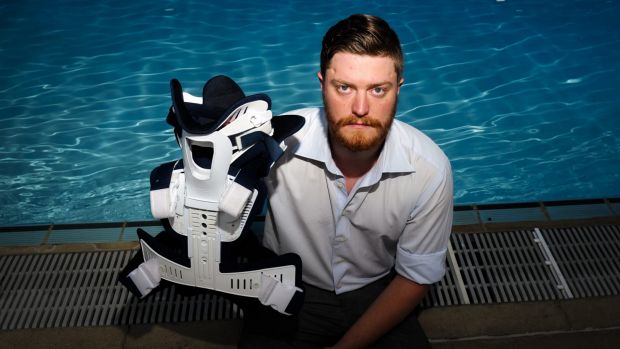
Dean Folino, of Higgins, injured himself badly when entering the water. Photo: Melissa Adams
It’s not until you get fairly close to Dean Folino’s face that two small bolt holes on either side of his forehead become apparent. He turns around to reveal a matching pair of scars on the back of his skull where the hair no longer grows.
“It wasn’t when they screwed them in that hurt the most,” he shrugs as he describes the way the halo brace was drilled into his skull. “It was taking them out three months later.”
Nearly a year after hitting his head on the bottom of a friend’s backyard pool in Chifley, 27-year-old Mr Folino can now move a little more freely, having regained most of his movement from the crushed C1 and C2 vertebra that left him immobilised after he found himself floating face down, unable to move his arms and with blood trickling out of his head.

Dean shows the indentations left after having screws drilled into his skull. Photo: Melissa Adams
According to ACT Health records, he is one of more than 3600 Canberrans who were treated for head and neck injuries in 2014, part of a growing number around the nation that has local and international experts worried.
Australian research into concussion and traumatic head injuries is increasingly pointing to links between blows to the head and dementia-related conditions like Alzheimer’s disease in later life. And Victorian research suggests as few as 10 per cent of all concussions are being properly assessed and treated, with many sufferers unaware of the health risks.
ACT junior rugby league president Martin Sullivan said his sport had been at the forefront of recognising the risk of head injuries, and improvements to training for coaches, better education about tackling techniques and strict protocols about treatment had made it much safer for young players. But there were still parents who were willing to let their children go back into a game after a head knock.

Dean was one of more than 3600 Canberrans who were treated for head and neck injuries in 2014. Photo: Melissa Adams
“It’s our job to say, no, those parents don’t understand that if a child gets another knock in that same area, within two to three weeks, they have a 70 per cent chance of a serious or potentially fatal injury. It’s that serious and we take it very seriously,” Mr Sullivan said.
While high-profile head injuries like that suffered by cricketer Phillip Hughes or footballer Sam Burgess have attracted significant attention, some including former Wallaby and former ACT Brumbies winger Clyde Rathbone, believe there is potentially an even greater issue involving repeated, low-level head knocks.
Experts agree, with leading research at the Melbourne Brain Centre pointing towards buildups in the brains of concussion suffers that have also been found in the brains of Alzheimer’s sufferers.
“I think the research is becoming increasingly damning for contact sports, the data speaks for itself,” Rathbone said.
“There is growing awareness, but like anything it starts off as a trickle. When we look upon contact sport in 50 years people will ask, ‘why were we playing like that?’. I’d take a punt and say in 100 years all contact sport will have fizzled out.”
